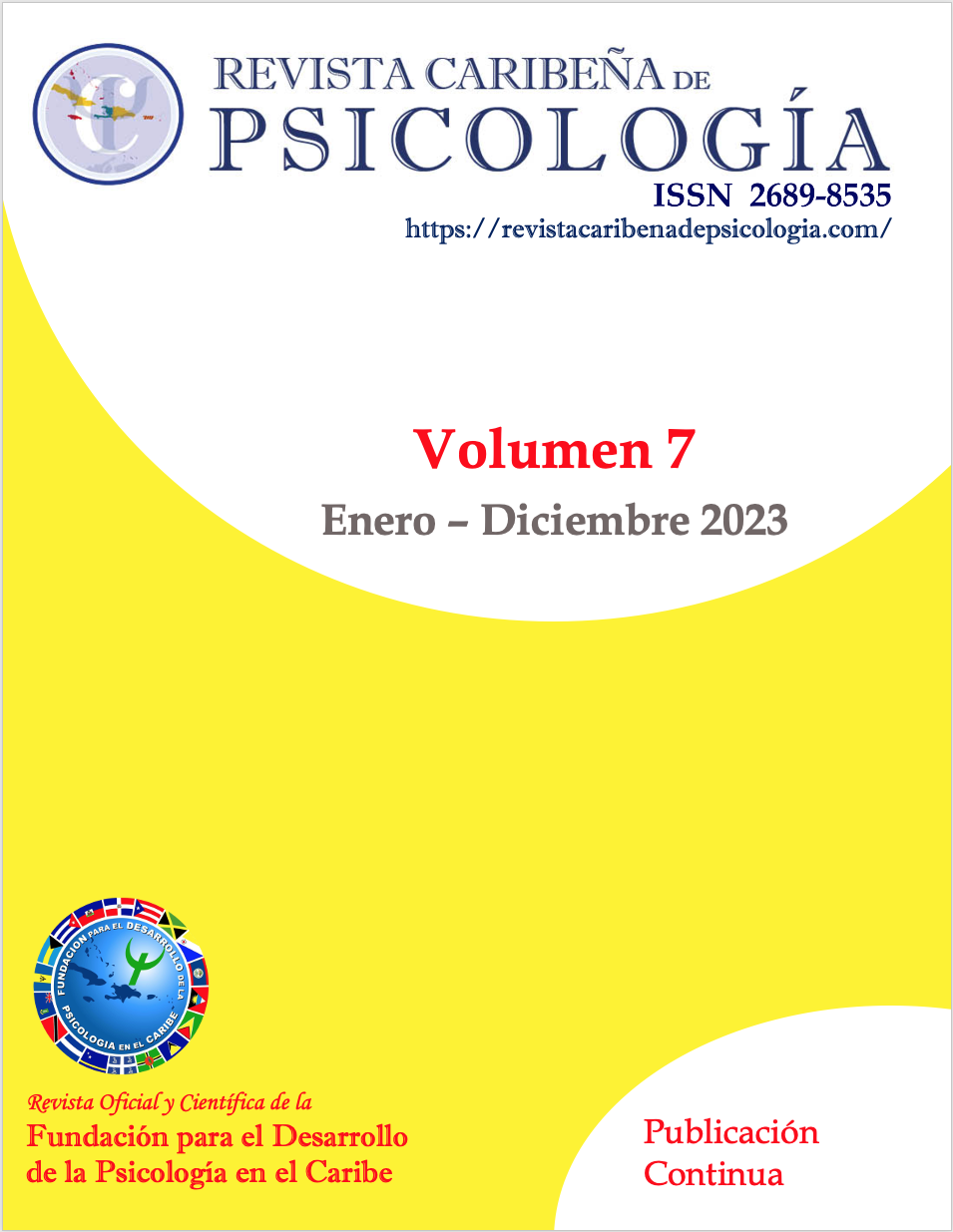Escala de Experiencias Disociativas – Taxón (DES-T): Evidencias de Validez y Uso Clínico en Puerto Rico
DOI:
https://doi.org/10.37226/rcp.v7i1.7245Palabras clave:
disociación, Escala de Experiencias Disociativas, evaluación, propiedades psicométricasResumen
La DES-T es una versión modificada de la Escala de Experiencias Disociativas compuesta de ocho ítems que miden específicamente disociación patológica: desrealización, despersonalización y alteración de la identidad. El presente trabajo tuvo como propósito analizar las propiedades psicométricas de la DES-T y examinar si la pertenencia al taxón disociativo indica realmente una disociación patológica, es decir, si estar en el taxón es sinónimo de tener un trastorno disociativo. La muestra del estudio fue de 341 participantes. Los resultados reflejaron que la DES-T tiene una consistencia interna aceptable (α = .87; w = .88) y una estructura unidimensional con un buen ajuste. Los ocho ítems de la escala cumplieron con los criterios de discriminación. Se encontró que las personas con trastornos disociativos obtuvieron puntuaciones significativamente más altas en la DES-T que las personas con otros trastornos de salud mental. Estos resultados preliminares sugieren que la DES-T es un instrumento confiable y valido para medir la frecuencia de disociación patológica. No obstante, se concluye que estar en el taxón disociativo indica una mayor frecuencia de experiencias disociativas, pero no indica necesaria o categóricamente la presencia de un trastorno disociativo.
Citas
American Psychiatric Association. (2022). Diagnostic and statistical manual of mental disorders (5th ed., text rev.). https://doi.org/10.1176/appi.books.9780890425787
Ato, M., López, J. J., & Benavente, A. (2013). Un sistema de clas-ificación de los diseños de investigación en psicología. Anales de Psicología, 29(3), 1038-1059.
Bernstein, E. M., & Putnam, F. W. (1986). Development, reliabil-ity, and validity of a dissociation scale. The Journal of Nervous and Mental Disease, 174(12), 727–735. https://doi.org/10.1097/00005053-198612000-00004
Byrne, B. M. (2010). Structural equation modeling with AMOS: Basic concepts, applications, and programming. Psychology Press.
Carlson, E. B., & Putnam, F. W. (1993). An update on the Dissoci-ative Experiences Scale. Dissociation: Progress in the Dissociative Disorders, 6(1), 16–27.
DeVellis, R. F. (2017). Scale development: Theory and applications (4th Ed). Sage Publications.
Doornik, J. A., & Hansen, H. (2008). An omnibus test for univari-ate and multivariate normality. Oxford Bulletin of Economics and Statistics, 70(1), 927–939. https://doi.org/10.1111/j.1468-0084.2008.00537.x
Giesbrecht, T., Merckelbach, H., & Geraerts, E. (2007). The disso-ciative experiences taxon is related to fantasy proneness. The Journal of Nervous and Mental Disease, 195(9), 769–772. https://doi.org/10.1097/NMD.0b013e318142ce55
González-Rivera, J. A. (2023). Dissociative Experiences Scale (DES-II): Psychometric Analysis in Puerto Rico and Contributions to the Discussion of the Factor Structure [Manuscript submitted for publication].
Hair, J. F., Black, W. C., Babin, B. J., & Anderson, R. E. (2010). Multivariate Data Analysis (7th ed.). Prentice Hall.
Hankins, M. (2008). How discriminating are discriminative in-struments? Health and Quality of Life Outcomes, 6(1), 36. http://doi.org/10.1186/1477-7525-6-36
Kate, M.-A., Hopwood, T., & Jamieson, G. (2019). The prevalence of dissociative disorders and dissociative experiences in col-lege populations: A meta-analysis of 98 studies. Journal of Trauma and Dissociation, 21(1), 16–61. https://doi.org/10.1080/15299732.2019.1647915
Kline, T. J. (2005). Psychological testing: A practical approach to de-sign and evaluation. Sage.
Leavitt, F. (1999). Dissociative experiences scale taxon and meas-urement of dissociative pathology: Does the taxon add to an understanding of dissociation and its associated pathologies? Journal of Clinical Psychology in Medical Settings, 6(4), 427–440. https://doi.org/10.1023/A:1026275916184
Martínez-Taboas, A. (1995). The use of the Dissociative Experi-ences Scale in Puerto Rico. Dissociation: Progress in the Dissocia-tive Disorders, 8(1), 14–23.
Martínez-Taboas, A., Canino, G., Wang, M. Q., García, P., & Bra-vo, M. (2006). Prevalence and victimization correlates of pathological dissociation in a community sample of youths. Journal of Traumatic Stress, 19(4), 439–448. https://doi.org/10.1002/jts.20144
Martínez-Taboas, A., Shrout, P. E., Canino, G., Chavez, L. M., Ramírez, R., Bravo, M., Bauermeister, J. J., & Ribera, J. C. (2004). The psychometric properties of a shortened version of the Spanish Adolescent Dissociative Experiences Scale. Jour-nal of Trauma & Dissociation, 5(4), 33–54. https://doi.org/10.1300/J229v05n04_03
Merckelbach, H., Rassin, E., & Muris, P. (2000). Dissociation, schizotypy, and fantasy proneness in undergraduate stu-dents. The Journal of Nervous and Mental Disease, 188(7), 428–431. https://doi.org/10.1097/00005053-200007000-00006
Merritt, R. D., & You, S. (2008). Is there really a dissociative taxon on the dissociative experiences scale? Journal of Personality As-sessment, 90(2), 201–203. https://doi.org/10.1080/00223890701845492
Modestin, J., & Erni, T. (2004). Testing the dissociative taxon. Psychiatry Research, 15(1), 77–82. https://doi.org/10.1016/j.psychres.2001.12.001
Montes, S. A., Ledesma, R. D., & Poó, F. M. (2011). Evaluación psicométrica de una versión modificada de la Escala de Expe-riencias Disociativas (DES-M). Revista Argentina de Clínica Psicológica, 20(1), 67-90. https://www.redalyc.org/pdf/2819/281921807006.pdf
Pope, C. A., & Kwapil, T. R. (2000). Dissociative experience in hypothetically psychosis-prone college students. The Journal of Nervous and Mental Disease, 188(8), 530–536. https://doi.org/10.1097/00005053-200008000-00009
Rassin, E., Merckelbach, H., & Spaan, V. (2001). When dreams become a royal road to confusion: Realistic dreams, dissocia-tion, and fantasy proneness. The Journal of Nervous and Mental Disease, 189(7), 478–481. https://doi.org/10.1097/00005053-200107000-00010
Ross C. A. (2021). The Dissociative Taxon and Dissociative Identi-ty Disorder. Journal of Trauma & Dissociation, 22(5), 555–562. https://doi.org/10.1080/15299732.2020.1869645
Ross, C. A., Goode, C., & Schroeder, E. (2018). Treatment out-comes across ten months of combined inpatient and outpa-tient treatment in a traumatized and dissociative patient group. Frontiers in the Psychotherapy of Trauma and Dissociation, 19(5), 87–100. https://doi.org/10.1080/15299732.2018.1451807
Satorra, A., & Bentler, P. M. (2001). A scaled difference chi-square test statistic for moment structure analysis. Psy-chometrika, 66(4), 507-514. https://doi.org/10.1007/BF02296192
Waldo, T. G., & Merritt, R. D. (2000). Fantasy proneness, dissocia-tion, and DSM-IV axis II symptomatology. Journal of Abnormal Psychology, 109(3), 555–558. https://doi.org/10.1037/0021-843X.109.3.555
Waller, N. G., Putnam, F. W., & Carlson, E. B. (1996). Types of dissociation and dissociative types: A taxometric analysis of dissociative experiences. Psychological Methods, 1(3), 300–321. https://doi.org/10.1037/1082-989X.1.3.300
Waller, N. G., & Ross, C. A. (1997). The prevalence and biometric structure of pathological dissociation in the general popula-tion: Taxometric structure and behavior genetic findings. Journal of Abnormal and Social Psychology, 106(4), 499–510. https://doi.org/10.1037/0021-843X.106.4.499
Descargas
Publicado
Cómo citar
Número
Sección
Licencia
Derechos de autor 2023 Juan Aníbal González-Rivera

Esta obra está bajo una licencia internacional Creative Commons Atribución 4.0.







